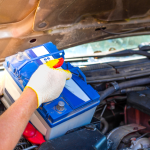As electric vehicles continue to gain popularity, Tesla has emerged as a frontrunner in the EV market, captivating drivers with its innovative technology and impressive performance. One of the most essential components of any electric vehicle is its battery, and for Tesla owners and prospective buyers alike, understanding battery longevity is crucial. How long can you expect your Tesla’s battery to last? What factors influence its lifespan, and how does it compare to traditional gas-powered vehicles?
In this article, we’ll delve into everything you need to know about Tesla battery lifespan, including the science behind it, real-world experiences, and tips on maximizing battery health. Whether you’re a current Tesla owner or simply curious about making the switch, we’re here to help you navigate the electrifying world of Tesla batteries!
Table of Contents
- Understanding Tesla Battery Life Expectations
- Factors Influencing the Longevity of Tesla Batteries
- Maintenance Tips to Extend Your Tesla Battery’s Lifespan
- What to Do When Your Tesla Battery Needs Replacement
- Q&A
- To Conclude

Understanding Tesla Battery Life Expectations
When looking at Tesla battery life, it’s essential to understand that several factors influence overall longevity. Most Tesla owners can expect their batteries to last between 300,000 to 500,000 miles before they start to degrade significantly. This exceptional lifespan is primarily due to the advanced lithium-ion technology utilized in Tesla vehicles, which is engineered to withstand thousands of charging cycles. Moreover, Tesla’s robust battery management systems actively monitor and optimize battery performance, contributing to a more extended lifespan.
However, individual experiences with battery life can vary based on driving habits, charging practices, and environmental conditions. To maximize the life of your Tesla battery, consider the following tips:
- Avoid frequent fast charging: While convenient, regular use of Superchargers can lead to faster degradation.
- Keep the battery charged: Try to maintain a charge level between 20% and 80% for optimal health.
- Utilize regenerative braking: This feature helps to recharge the battery while driving, extending its life.
For a clearer understanding of Tesla battery life expectations, here’s a brief comparison of different models:
| Model | Estimated Range (miles) | Battery Warranty (years) |
|---|---|---|
| Model S | 396 | 8 |
| Model 3 | 358 | 8 |
| Model X | 348 | 8 |
| Model Y | 330 | 8 |
Factors Influencing the Longevity of Tesla Batteries
When considering the lifespan of Tesla batteries, several key factors play a crucial role. Battery chemistry is a primary influence; Tesla utilizes lithium-ion technology, which is known for its efficiency and longevity compared to other battery types. Additionally, temperature control is essential; extreme heat or cold can degrade battery performance and reduce lifespan. Tesla vehicles are designed with sophisticated thermal management systems that help maintain optimal temperatures, mitigating detrimental effects on the battery over time.
Another significant factor is charging habits. Regularly charging to 100% or fully depleting the battery can lead to accelerated wear. Tesla recommends keeping the state of charge between 20% and 80% for daily use to enhance battery longevity. Moreover, driving patterns also play a role; aggressive acceleration and frequent high-speed driving may put additional strain on the battery. By adopting gradual driving habits and utilizing regenerative braking, drivers can optimize battery life and performance.
Maintenance Tips to Extend Your Tesla Battery’s Lifespan
To keep your Tesla battery healthy and prolong its lifespan, regular maintenance practices are essential. Charging habits play a crucial role; try to avoid letting your battery drop below 20% and refrain from charging it to 100% on a regular basis. Instead, aim for a charge level between 20% and 80%. This practice reduces the stress on the battery and helps maintain its overall efficiency. Additionally, consider using a home charging station with a lower amperage to ease the charging process, as faster charging can generate excess heat that may harm the battery over time.
Another vital aspect of battery maintenance is to monitor the temperature. Tesla batteries operate best at moderate temperatures, so, whenever possible, park in shaded areas or garages to shield the vehicle from extreme heat or cold. Regular software updates from Tesla can also help optimize battery performance, so keep your system updated. Furthermore, consider following a driving style that encourages energy efficiency; smoother acceleration and deceleration can lead to less strain on your battery. By implementing these tips, you’ll not only enhance your Tesla’s performance but also extend the life of its battery.
What to Do When Your Tesla Battery Needs Replacement
When the time comes for your Tesla battery to be replaced, it’s essential to approach the process with care and knowledge. Start by contacting Tesla or an authorized service center to get a clear understanding of the options available to you. They will typically provide information on the various battery types compatible with your specific model, along with details on costs and warranties. Consider factors such as performance, range, and charging speed when selecting a replacement option. Additionally, many Tesla service centers offer trade-in programs for your old battery, which can help offset some of the replacement costs.
While you’re awaiting your replacement, there are several steps you can take to ensure your vehicle remains operational. First, monitor the battery’s performance and charge levels closely to prevent complete depletion. Next, consider adjusting your driving habits to conserve energy, such as using regenerative braking and planning your trips to minimize excessive usage. Lastly, keep your Tesla plugged in whenever possible, as this will help maintain the battery’s health during the waiting period. Below is a simple table summarizing key considerations during this transition:
| Key Consideration | Action |
|---|---|
| Consult Tesla | Contact for options & pricing |
| Monitor Performance | Keep an eye on charge levels |
| Adjust Driving Habits | Use regenerative braking & plan trips |
| Charging | Stay plugged in when possible |
Q&A
Q&A:
Q1: What is the average lifespan of a Tesla battery?
A: The average lifespan of a Tesla battery is typically around 300,000 to 500,000 miles, depending on the model and usage. Tesla batteries are designed to last for a long time, and many drivers report that they can expect their battery to maintain a good portion of its capacity for several years.
Q2: How does battery longevity vary between different Tesla models?
A: Different Tesla models have varying battery sizes and chemistries, which can affect longevity. For example, the Model S and Model X generally have larger battery capacities, allowing them to potentially last longer than the smaller Model 3 and Model Y. However, variations in driving patterns and environmental factors also play a crucial role in battery life.
Q3: What factors can impact the lifespan of a Tesla battery?
A: Several factors can influence the lifespan of a Tesla battery, including driving habits, charge cycles, climate conditions, and how frequently the vehicle is charged. For instance, consistently charging the battery to 100% and depleting it to low levels can shorten its lifespan. It’s generally recommended to keep the battery charged between 20% and 80% for optimal health.
Q4: Is there a warranty on Tesla batteries?
A: Yes, Tesla provides a warranty on its batteries that typically lasts 8 years or up to 150,000 miles (whichever comes first) for the Model 3 and up to 200,000 miles for the Model S and Model X. This warranty covers battery defects and assures drivers that they can expect a certain level of performance during the warranty period.
Q5: Can you replace a Tesla battery?
A: Yes, Tesla batteries can be replaced, although it’s a significant investment. As battery technology evolves, replacement batteries may also provide improved performance and longevity compared to the original. It’s advisable to discuss battery replacement options with Tesla service centers for the most accurate information.
Q6: What happens to the battery once it reaches the end of its life?
A: When a Tesla battery reaches the end of its useful life, it can be recycled or repurposed. Tesla is committed to sustainability and has initiatives in place for battery recycling, recovering valuable materials to be used in new batteries. This not only helps with environmental conservation but also contributes to the circular economy.
Q7: How can Tesla owners maximize the lifespan of their battery?
A: To maximize battery lifespan, Tesla owners should adopt a few best practices: avoid frequent fast charging, limit full discharges, charge regularly within the optimal range (20%-80%), and keep the car parked in a temperature-controlled environment if possible. Additionally, utilizing Tesla’s software updates and battery management features can help maintain battery health.
Q8: Are there any signs that my Tesla battery may be failing?
A: Yes, there are a few signs that may indicate a battery issue, such as a noticeable decrease in range, longer charging times, or frequent alerts from the vehicle regarding battery health. If you experience any of these symptoms, it’s best to have your Tesla checked by a professional to diagnose any potential problems.
Q9: What is the future of Tesla battery technology?
A: Tesla is continuously investing in research and development to improve battery technology, aiming for longer lifespans, faster charging times, and lower costs. The company is also exploring new battery chemistries, such as the development of solid-state batteries, which could revolutionize the electric vehicle market.
Q10: Where can I find more information about Tesla batteries?
A: For more detailed information, you can visit Tesla’s official website or the Tesla Communities forum, where you can connect with other owners and enthusiasts. Additionally, Tesla’s customer support is always available to answer specific questions about your vehicle and its battery system.
Feel free to dive into the world of Tesla with confidence, knowing that battery longevity and care are manageable with the right information!
To Conclude
understanding how long a Tesla battery lasts is essential for any current or prospective electric vehicle owner. From the impressive longevity of the battery itself to the various factors that can influence its lifespan, being informed is key to maximizing your investment. With proper maintenance and care, Tesla batteries can serve you reliably for many years, making them a sustainable choice for environmentally conscious drivers. Whether you’re driving across town or embarking on a road trip, knowing what to expect from your Tesla’s battery can enhance your overall driving experience. If you have any more questions or need further information, don’t hesitate to reach out to Tesla’s support or consult your vehicle’s manual. Happy driving!










